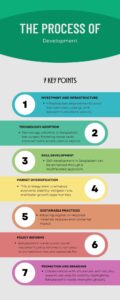How to develop Textile sector in Bangladesh
Introduction: Bangladesh has made significant strides in various domains, notably in infrastructure development, technology adoption, skill enhancement, market diversification, sustainable practices, policy reforms, and strategic promotion and branding, particularly within its textile sector. Robust investments in infrastructure, ranging from transportation and energy to telecommunications, have bolstered connectivity and economic growth.

There are a few key points about How to Develop Textile sector in Bangladesh.
Investment and infrastructure: Bangladesh has been actively enhancing its infrastructure through investments to bolster economic growth and development. Infrastructure improvement initiatives encompass diverse sectors such as transportation, energy, and telecommunications. Investments in roads, bridges, and ports aim to enhance connectivity, enabling efficient movement of goods and people.
The energy sector receives attention through projects focusing on renewable energy sources, aiming for sustainability and power stability. Additionally, telecommunications infrastructure upgrades, including the expansion of internet connectivity, contribute to digital inclusion and economic progression. Investment initiatives often involve collaborations with international entities, fostering expertise exchange and financial support. These infrastructure advancements play a pivotal role in attracting foreign investment, stimulating trade, and fostering economic resilience in Bangladesh, ultimately enhancing the country’s competitiveness on the global stage and this why writer tried to elaborate on How to Develop Textile sector in Bangladesh.
Technology Adoption: Technology adoption in Bangladesh has surged, fostering remarkable improvements across various sectors. The proliferation of mobile technology has significantly enhanced communication and connectivity, enabling widespread access to information and services, particularly in rural areas. The adoption of digital payment systems has streamlined financial transactions, empowering financial inclusion for previously unbanked populations.
In the agricultural domain, the implementation of innovative technologies such as precision farming, weather forecasting apps, and crop monitoring tools has bolstered productivity and resilience against climate change. The healthcare sector has witnessed advancements through telemedicine services, facilitating access to medical expertise in remote regions.
Furthermore, e-commerce platforms have revolutionized the retail landscape, offering convenience and accessibility to a broader consumer base. Initiatives promoting tech education and skill development have contributed to a more tech-savvy workforce, driving economic growth and innovation. Despite challenges, Bangladesh’s concerted efforts in technology adoption have played a pivotal role in socioeconomic development, fostering a more inclusive and technologically empowered society and How to develop Textile sector in Bangladesh.
Skill Development: Skill development in Bangladesh can be enhanced through a multifaceted approach. Firstly, investing in vocational training programs aligned with industry needs is crucial. Collaborations between educational institutions, government bodies, and industries can bridge the gap between theoretical learning and practical skills demanded by the job market. Secondly, promoting entrepreneurship and innovation through incubation centers and startup initiatives can nurture creativity and problem-solving abilities among the youth. Digital Marketing for Textile is now counted for Textile.
Furthermore, emphasis on digital literacy and technological skills should be integrated into the education system to adapt to the evolving global landscape. Encouraging lifelong learning through continuous upskilling and reskilling programs ensures professionals stay relevant in their respective fields. Additionally, mentorship programs and access to online resources facilitate knowledge transfer and skill acquisition.
Ultimately, How to Develop Textile sector in Bangladesh, a comprehensive strategy involving public-private partnerships, curriculum reforms, technological integration, and a culture of continuous learning is pivotal for sustainable skill development in Bangladesh.
Market Diversification: Market diversification in Bangladesh involves expanding the range of products and exploring new markets to reduce reliance on a few industries or export destinations. This strategy aims to enhance economic stability, mitigate risks, and foster growth opportunities. By diversifying into new sectors such as technology, pharmaceuticals, and renewable energy, Bangladesh can reduce its dependence on the ready-made garment industry.
Additionally, exploring untapped international markets in Africa, Latin America, and Southeast Asia can lessen dependency on traditional trade partners. Government policies supporting innovation, investment in infrastructure, and fostering a skilled workforce are crucial for successful diversification. Through this approach, Bangladesh can create a more resilient economy, generate employment, attract foreign investments, and establish a competitive edge in diverse global markets, ultimately leading to sustainable economic development and How to develop Textile sector in Bangladesh.
Sustainable Practices: Bangladesh’s textile sector can enhance sustainability through several practices. First, implementing water recycling and efficient dyeing techniques minimizes water usage and pollution. Adopting organic or recycled materials reduces environmental impact and promotes eco-friendly production. Investing in renewable energy sources like solar power decreases reliance on fossil fuels, cutting greenhouse gas emissions. Embracing ethical labor practices ensures fair wages, safe working conditions, and workers’ rights, fostering a sustainable workforce and How to develop Textile sector in Bangladesh.
Collaborations with international organizations and certifications like Global Organic Textile Standard (GOTS) or Leadership in Energy and Environmental Design (LEED) validate sustainable efforts, enhancing market competitiveness. Additionally, education and awareness campaigns within the industry promote sustainable practices among stakeholders. By integrating these strategies, Bangladesh’s textile sector can advance sustainability, meeting global demands while prioritizing environmental and social responsibility.
Policy Reforms: Bangladesh’s textile sector could implement policy reforms to enhance its competitiveness and sustainability. Firstly, investing in technological advancements and innovation would modernize production methods, improving efficiency and product quality. Implementing stricter environmental regulations and sustainable practices would mitigate the sector’s ecological impact, promoting eco-friendly production processes and waste management.How to Develop Textile sector in Bangladesh.
Additionally, fostering skill development programs and investing in education would elevate the workforce’s expertise, leading to better productivity and higher-value products. Encouraging fair labor practices and ensuring workers’ rights and safety would improve the industry’s global reputation and attract ethically conscious consumers and investors.

Promotion and Branding: In Bangladesh’s textile sector, a strategic focus on promotion and branding can drive significant improvement. Effective promotion involves leveraging digital platforms, trade shows, and targeted advertising to showcase the industry’s quality, innovation, and sustainability practices. Collaborations with influencers and industry experts can amplify visibility, highlighting Bangladesh’s textile strengths globally.
Branding efforts should emphasize the nation’s commitment to ethical manufacturing, highlighting fair labor practices, eco-friendly processes, and product quality. Creating a unique brand identity that reflects cultural heritage while aligning with modern trends can distinguish Bangladeshi textiles in the international market. How to Develop Textile sector in Bangladesh.
Moreover, investment in R&D for advanced technologies and design innovation can enhance product diversity and quality, further elevating the industry’s reputation. Collaborations with global brands for co-branded collections can also increase visibility and credibility and How to Develop Textile sector in Bangladesh.
Ultimately, a comprehensive approach to promotion and branding will fortify Bangladesh’s textile sector, attracting international markets and fostering sustainable growth.
Government support: Bangladesh’s textile sector has received substantial government support aimed at fostering growth and improvement. Initiatives include policy reforms, financial aid, and infrastructural development. The government implemented favorable policies such as tax incentives, duty-free access to raw materials, and export-oriented strategies to stimulate the industry’s expansion. Financial assistance through subsidized loans, grants, and credit facilities has been extended to textile businesses, encouraging modernization and technology adoption. Infrastructure development, including specialized textile zones and industrial parks, has been prioritized to enhance productivity and efficiency and How to Develop Textile sector in Bangladesh.
Additionally, vocational training programs and skill development initiatives have been introduced to empower the workforce with advanced capabilities, ensuring a competitive edge in global markets. This comprehensive support framework underscores Bangladesh’s commitment to elevating the textile sector, contributing significantly to the nation’s economic development and global standing in the textile industry.
Bangladesh’s proactive initiatives in infrastructure development, technology adoption, skill enhancement, market diversification, sustainable practices, policy reforms, and strategic promotion and branding within its textile sector reflect a concerted effort toward holistic growth and sustainability. The country’s investments in diverse sectors have laid a robust foundation for economic resilience and global competitiveness.
Financial Support: Financial support plays a pivotal role in the development of the textile industry, encompassing various facets such as technology, infrastructure, and skill enhancement. Investments in textile manufacturing machinery, modernization of production processes, and research into sustainable materials are crucial aspects and How to develop Textile sector in Bangladesh.

Government subsidies and grants aid in establishing textile parks or clusters, providing a conducive environment for manufacturers with shared infrastructure and amenities, reducing operational costs and enhancing competitiveness. Financial incentives for adopting eco-friendly practices and implementing energy-efficient technologies encourage sustainable production.How to develop Textile sector in Bangladesh.
Moreover, financial aid directed towards skill development programs fosters a skilled workforce adept in modern techniques and technologies. These initiatives not only improve employment prospects but also elevate the overall quality and efficiency of textile production and How to Develop Textile sector in Bangladesh.
Private investments and venture capital further drive innovation in textile manufacturing. Funding research and development initiatives enable the discovery of new materials, techniques, and designs, ensuring the industry remains dynamic and responsive to evolving market demands.
Financial support acts as a catalyst, propelling the textile industry forward by enabling technological advancements, sustainable practices, and skill enhancement, ultimately contributing to its growth, competitiveness, and global significance and How to Develop Textile sector in Bangladesh.

Collaboration and Networking: The development of the textile industry in Bangladesh has been significantly influenced by collaboration and networking among various stakeholders. Bangladesh’s textile sector growth can be attributed to the collaborative efforts between the government, private sector, international organizations, and local communities.
Government initiatives have played a crucial role in fostering collaboration by implementing policies and incentives to attract foreign investment, provide infrastructural support, and ensure a conducive business environment. Moreover, the government has actively engaged in networking with international organizations, seeking partnerships for skill development, technology transfer, and market access.How to develop Textile sector in Bangladesh.
The private sector has contributed to the industry’s growth through collaborations with global brands, fostering technology transfer, and implementing sustainable practices. Networking among local textile businesses has led to the formation of clusters, allowing for shared resources, knowledge exchange, and increased efficiency.
Additionally, How to Develop Textile sector in Bangladesh, networking through trade fairs, exhibitions, and industry forums has facilitated connections between local manufacturers and international buyers, opening up export opportunities and enhancing the industry’s global presence.
Overall, collaboration and networking have been instrumental in propelling Bangladesh’s textile industry forward by leveraging collective expertise, resources, and opportunities for sustainable growth and development.
Conclusion: he strides made by Bangladesh in various domains, especially within its textile sector, underscore a comprehensive and concerted effort towards holistic growth and sustainability.How to develop Textile sector in Bangladesh. The nation’s emphasis on infrastructure development, technology adoption, skill enhancement, market diversification, sustainable practices, policy reforms, strategic promotion, and financial support has laid a robust foundation for economic resilience and global competitiveness. You can check one of my Brainchild article Textile to Tech Road.
- What is Textile?
- What is Branding?
- What is Technology adoption?